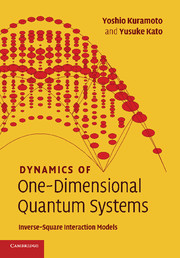8 - Yang–Baxter relations and orthogonal eigenbasis
from Part II - Mathematics related to 1/r2 systems
Published online by Cambridge University Press: 12 January 2010
Summary
The spectrum of the Sutherland model for fermions with spin has a degeneracy. The orthogonal set of the basis of the Fock space of degenerate states is usually related to a Lie algebra such as su2 and su3. In our case, however, the degeneracy extends to states with different values of total spin, and the ordinary Lie algebra is insufficient. The relevant algebra is called Yangian [43, 44], and is the algebra controlling those operators satisfying the Yang–Baxter relation [118, 178]. In this chapter we describe how the Yangian naturally emerges in the many-particle states described by Jack polynomials, and constructs an orthogonal basis of degenerate states. We concentrate here on the simplest case of the gl2 Yangian, corresponding to spin 1/2 particles. More general cases will be discussed in Chapter 9.
We introduce a variant of the R-matrix in Section 8.1, and its standard form in Section 8.2. We then introduce a monodromy matrix and discuss its algebraic properties, such as the Yang–Baxter relation and the intertwining property. In Section 8.4, we consider the action of the monodromy matrix on the set of states constituting the degenerate eigenstates. We will see that an element of the monodromy matrix plays the role of a creation or annihilation operator of orthogonal eigenfunctions. This means that all eigenfunctions can be generated algebraically from the highest-weight state, for example, by successive action of an element of the monodromy matrix. Thus, the degeneracy beyond the Lie algebra is accounted for by the symmetry of the monodromy matrix, which is nothing but the Yangian.
A demonstration of this construction will be given in Section 8.5 for the two-particle and three-particle systems.
- Type
- Chapter
- Information
- Dynamics of One-Dimensional Quantum SystemsInverse-Square Interaction Models, pp. 391 - 421Publisher: Cambridge University PressPrint publication year: 2009

